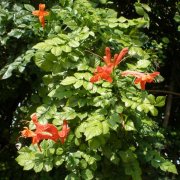Care of the climbing plant Tecoma capensis or Cape honeysuckle |
|
The genus Tecoma, family Bignoniaceae, comprises 14 species of shrubs and small trees native to America and South Africa. Some species are: Tecoma capensis, Tecoma stans, Tecoma rosifolia, Tecoma sambucifolia, Tecoma castanifolia. Common names: Cape honeysuckle, Cape Trumpet-Flower. This species is native to South Africa. They are fast-growing climbing shrubs that reach 3 meters (9.84 feet) in height. The leaves are evergreen except in cold climates; they are dark green, opposite and serrated edge. The tubular flowers appear in clusters and can be red, orange or apricot in color. They can bloom in different seasons of the year. Cape honeysuckle is used as isolated specimens and to cover pergolas and walls (it needs supports to climb). It attracts butterflies. Tecoma capensis needs full exposure but can grow in semi-shade. It does not resist frost. Cape Trumpet-Flower is an easy to grow plant that grows in any well-drained soil that is not alkaline. Water moderately, waiting until the soil has completely dried. Cape honeysuckle resists periods of drought. Fertilize with manure in late winter. Prune in late winter to strengthen the plant and control growth. Tecoma capensis can be attacked by mealybugs, whiteflies or fungi if there is excess watering. Cape honeysuckle is propagated in any season of the year by cuttings or by seeds. |
Images of the climbing plant Tecoma capensis or Cape honeysuckle |
Find plants
Tecoma capensis or Cape honeysuckle | Care and Growing
© 2026 FavThemes






